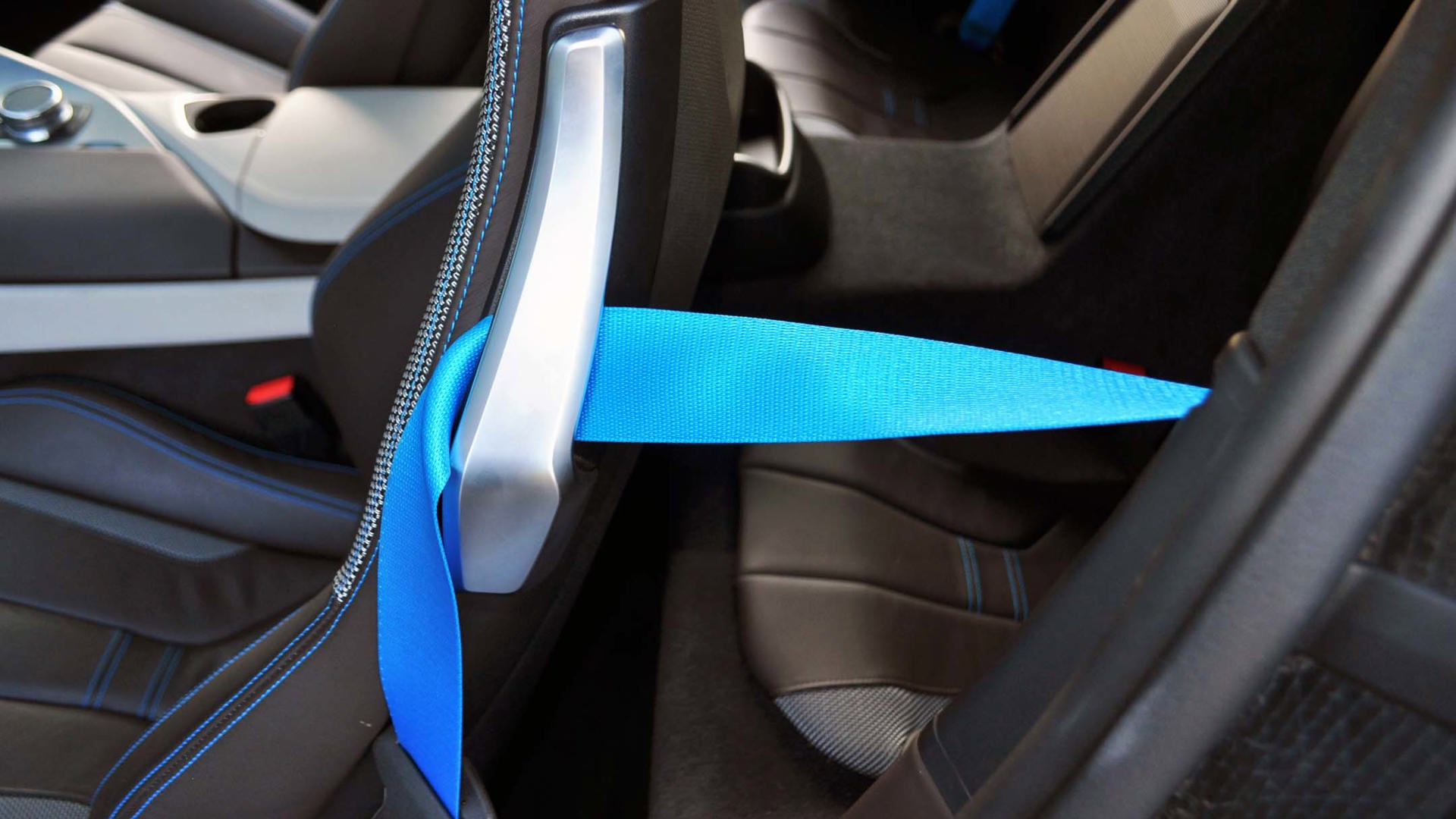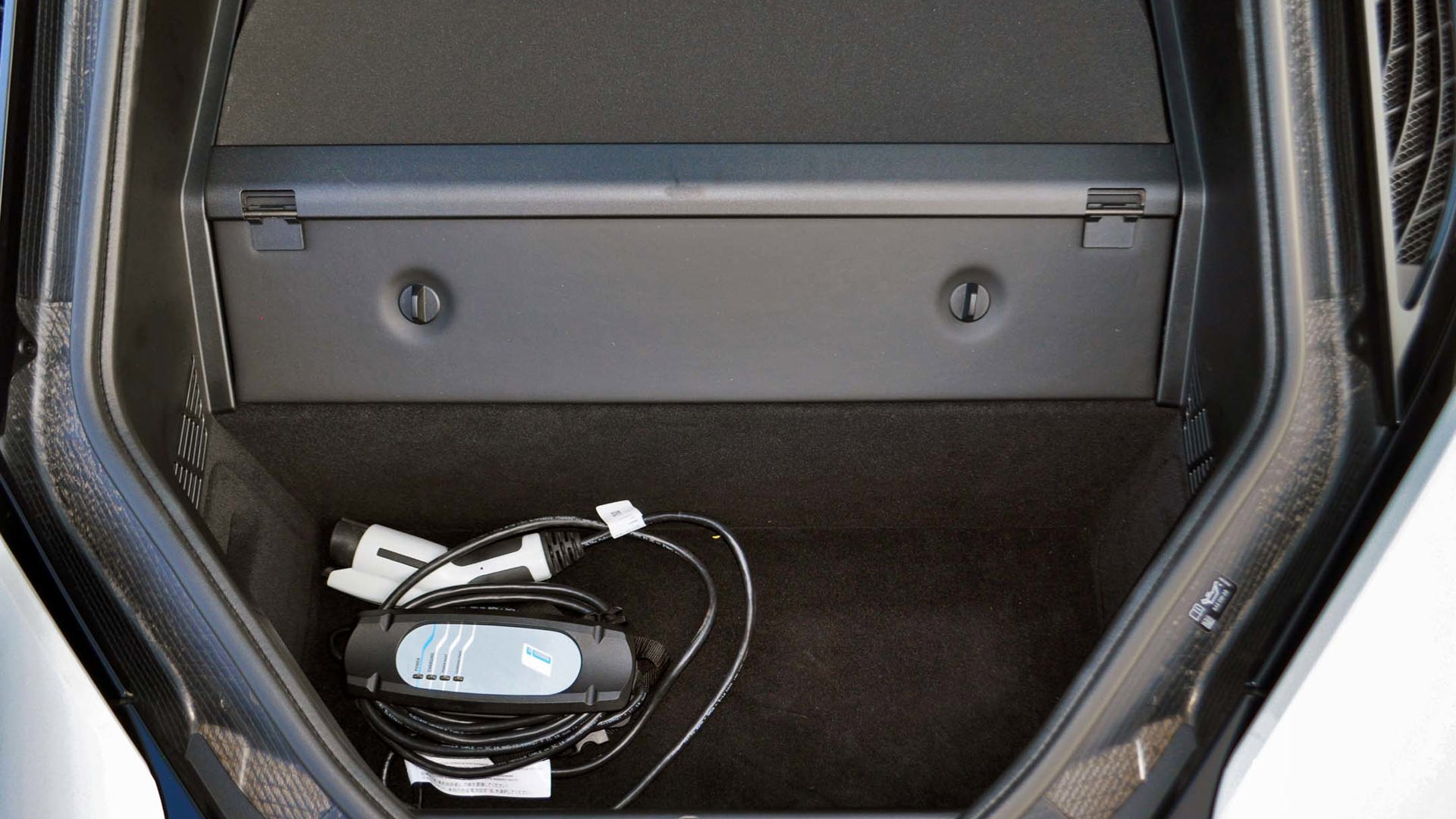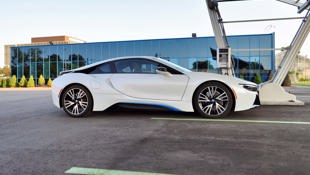 AutoTrader SCORE
AutoTrader SCORE
-
STYLING9/10
-
Safety9/10
-
PRACTICALITY8/10
-
USER-FRIENDLINESS8/10
-
FEATURES8/10
-
POWER9/10
-
COMFORT8/10
-
DRIVING FEEL9/10
-
FUEL ECONOMY9/10
-
VALUE8/10
Just one look at the BMW i8 tells you it’s an ambitiously futuristic exotic sports car. The super wide body, flamboyant butterfly doors that open up and out, plus the radical flying buttresses would not look out of place as a design mock-up of some wild concept sports car at any major auto show, even years after it hit the market for 2014.
With fuel efficiency mandates tightening all over the world, this is what the future of sports car performance will surely look like.
I’ll never forget seeing an electric blue version of this car parked next to a new Lamborghini Huracán coupe at a European performance car show last year, and how much larger the crowd gathered around the German three-cylinder BMW sports car compared to the lovely and even newer V10 Italian exotic. And the i8 starts at roughly half of what a new Huracán coupe runs, with this particular example running to $166,925 as tested.
Something tells me that Lambo’s owner was none too pleased.
Crowd-pleaser, for the most part
Attracting crowds and sparking conversations is one of the i8’s most potent abilities. Like with its mid-engined Lambo, R8 and McLaren rivals, you’ll find yourself stopping to chat with folks often: at the gas station, loading groceries, at soccer practice, and pretty much whenever you turn off the ignition and don’t immediately vacate the vicinity. The i8 is clearly not for introverted types, but then again, that’s the case for most of these flashy exotic sports cars.
In many of these conversations about the i8, the questions start out enthusiastically similar, but then often tended to taper off for many who assumed it was an all-conquering powerhouse, which isn’t quite the case.
Q: So what is this?
Me: An all-wheel drive plug-in hybrid BMW i8 sports car.
Q: Wow, nice; so how much power in this thing?
Me: About 357 hp, from a 1.5-litre three-cylinder turbo engine and a big electric motor up front.
I would watch the fervour slightly drain from their reaction. Some even said straight out they thought it’d have more power.
“But it has a very light carbon-fibre based body, so it feels faster than that,” I found myself repeating, noting the i8’s zero to 100 km/h time of 4.4 seconds was properly quick, but not the fastest sports car out there.
Clearly there are still many folks out there who expect such low-slung sports cars to have eye-popping horsepower figures and muscular turbo V8 or exotically brawny 10-cylinder engines. But then, most exotic sports cars also don’t get anywhere near the i8’s overall observed fuel consumption average of 8.1 L/100 km either. And with fuel efficiency mandates tightening all over the world, this is a sneak peek at what the future of sports car performance will surely look like - about 10 years early.
For right now, achieving Volkswagen Golf-like fuel efficiency may be appreciated by owners, but just doesn’t wow onlookers the same way.
Parking drama and/or gymnastics comes standard in tight spots
This 8.1 figure the i8 achieved in my week of fuel efficiency-friendly temperatures with it is slightly better even than its official 8.3 L/100 km average, even with plenty of Sport mode driving, since I plugged it in at various Level 2 (240-volt) chargers to maximize use of its paltry 24 km all-electric range.
Where I didn’t charge up more than once was in my single car garage, even with my L2 sitting there. That’s because the first time I pulled into it, I realized that the unique “butterfly” doors that swing up and out don’t do well in tighter habitats, whether they be smaller garages or crowded mall parking lots. So even with my pulling the i8 as much as possible to the passenger side of my suddenly thin garage, not only did the out-swinging driver’s door want to make contact with the wall, but there’s also a fairly high structural doorsill hump that has to be navigated up and over as well.
For folks who may innocently come out to their i8 in a parking lot and find that drivers have squeezed up next to them, the i8 could seriously use the remote control parking feature that’s available in the BMW 7 Series (as well as the Tesla Model S) where you can start and remotely roll the car backwards or forward into a spot using a special key or app, while standing outside the car.
The i8 does offer a special app that will allow you to turn on the climate control remotely, or check/stop/start the charge, but sadly no remote parking feature. Hopefully this feature is coming in the updated 2018 i8 coupe BMW promises for spring ’18, when a convertible i8 version will also arrive, and both will receive a larger battery (up to 11.6 kilowatt-hours from the current 7.1), increased all-electric range closer to 29 km (18 miles), and a slightly increased 369 hp combined output as well.
Another interior item that could use improvement is the lack of AM radio, at all. Yes, it will catch the digital versions of some stations that will broadcast on alternate FM frequencies, but if you like to listen to sports or talk radio on AM stations without an alternate feed, you’re out of luck. The AM option doesn’t even show up in the various Band choices, which BMW says is due to radio interference caused by the battery or associated systems, and its high standards for sound quality, which prevents AM from being offered on the i3 hatchback as well.
But that argument doesn’t fly when every other electric car in the industry offers AM radio that sounds fine, or at least as good as AM radio sounds in other vehicles.
Driving the i8 is involving, but often different than expected
Once unplugged and you’ve stretched up and out to close those attention-generating doors, the interior that awaits you is clearly driver-focused, but closer to a traditional BMW ambiance. A cockpit feel is produced by a centre console, screen and dashboard all canted towards the driver, with blue “i” accent colours embedded in the steering wheel, on the leather stitching throughout, and least subtly on the bright blue seatbelts.
Next to the shifter lies the Start/Stop button that’s cantilevered up towards the driver, with an eDrive button directly underneath. When pushed, this e-drive mode attempts to keep you floating on electrons for as long as possible. Like other plug-in hybrids, this period of all-electric near-silence adds to the car’s comfort and futuristic drive feel. Unless you aggressively mash the throttle, the i8 can stay in this mode up to 120 km/h.
In the default Comfort mode, assuming there’s charge in the battery of course, the i8 will also cruise along silently in all-electric mode, but the throttle threshold for the engine kicking in for extra propulsion is lower. An EcoPro mode reduces throttle and climate control response, but seems like overkill when there’s already a mode that largely uses zero gasoline – really, how efficient do you have to get in a car like this?
The most entertaining mode by far is Sport mode, which banishes all-electric silence and instantly turns the digital speedo and tach an angry red from Normal’s grey and Eco’s blue. This mode also amplifies BMW’s piped in synthetic engine noise, which the maestros at BMW blend fairly harmoniously with the 1.5L three-cylinder that powers the rear wheels. It doesn’t have the shrieking rip of a Ferrari 488 or guttural ferocity of a Lambo or McLaren, but it’s sonorous enough to entice you to work the shift paddles hard, with a sound that’s very nearly as gratifying as on non-plug-in performance hybrids such as the Lexus LC500h or Acura NSX.
Wait, shift paddles, in a plug-in? That’s right, there’s a six-speed Steptronic transmission connecting the engine behind those tiny rear seats to the rear wheels, while the electric motor runs the front wheels via a two-speed automatic gearbox, creating a performance-oriented all-wheel drivetrain in most circumstances. Which also means that when driven in all-electric mode, the i8 is temporarily a butterfly-doored exotic sports car with front-wheel drive.
As futuristic as this car feels to drive and look at, the i8 truly earns its performance car chops in the handling department. Attack a tight highway ramp, and the front end will tuck in obediently wherever you’d like to place it, with no body lean or tire howl to dissuade you from very un-green tire punishment. I suspect its green limitations may come more to the fore on a racetrack, but judging by over 300 km’s worth of highway, back road and city street driving, its sporting limits are much higher than can be reasonably maxed on public roads.
Should you try pushing this car at night, the industry’s first laserlight headlights will help guide your way from an even further distance than the standard all-LEDs, an $8,000 option equipped on this tester that took some doing to be allowed into North America, but are now here. The i8’s top speed is a worthy but not crazy 250 km/h, and even the tires are an aggressively sporting but still somewhat thin-for-an-exotic 215/45R20s up front, with meatier 245/40R20s in the rear.
BMW i8 helped a new genre of exotic yet green sports car emerge
The i8 was the first of a new breed of six-figure exotic sports cars that now include hybrids like the Acura NSX and Lexus LC500h that aim to show that making fuel efficiency a priority does not mean that automotive beauty or driving pleasure need to be sacrificed. But the i8 one-ups these rivals by not only coming to market first, but coming to market with a more aggressively “green” and advanced plug-in technology, combined with performance and efficiency-helping carbon-fibre plastic body structure.
Sure, one could argue that the seven-figure (and much quicker) Porsche 918 Spyder hypercar introduced in 2013 was truly the first plug-in hybrid exotic sports car. But when you’re talking over a million dollars after taxes, one can better appreciate the ambition of BMW of introducing the i8 nearly four years ago. All of a sudden the i8 is leading this electrified pack in technology, handling and fuel efficiency, if not quite with the outright power, speed and traditional sound of the more Neanderthal if dynamically entertaining gas-only brutes.
| Engine Displacement | 1.5L |
|---|---|
| Engine Cylinders | turbocharged 3-cylinder plug-in hybrid |
| Peak Horsepower | 357 hp @ 5,800 rpm |
| Peak Torque | 420 lb-ft @ 3,700 rpm |
| Fuel Economy | 8.4/8.1/8.3 city/hwy/combined |
| Cargo Space | 154 L |
| Model Tested | 2017 BMW i8 |
| Base Price | $149,900 |
| A/C Tax | 100 |
| Destination Fee | $2,245 |
| Price as Tested | $166,925 |
|
Optional Equipment
$14,700 – Halo Interior World package (Black Brake Calipers
Leather Engine Cover
BMW Display Key
BMW i Blue Seat-Belt
LED Adaptive Headlights
Dalbergia Brown Natural Leather with Cloth Accent); $8,000 – Laser Headlights
|
|






































































